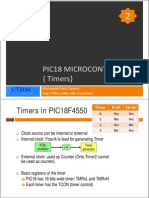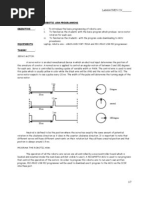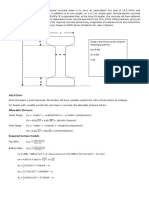Chapter3-Input Output Ports Programming
Uploaded by
adamwaizChapter3-Input Output Ports Programming
Uploaded by
adamwaizINPUT OUTPUT PORTS PROGRAMMING
Depending on the device selected and features enabled, there are up to five ports available. Some pins of the I/O ports are multiplexed with an alternate function from the peripheral features on the device. In general, when a peripheral is enabled, that pin may not be used as a general purpose I/O pin.
Each port has three registers for its operation. These registers are: TRIS register (data direction register) PORT register (reads the levels on the pins of the device) LAT register (output latch)
LATx is used for writing an output. PORTx is for reading an input.
TRISx is used to configure the direction; an output (=0) or an input (=1).
The corresponding Data Direction register is TRISx. Setting a TRISx bit (= 1) will make the corresponding PORTx pin an input (i.e., put the corresponding output driver in a high-impedance mode). Clearing a TRISx bit (= 0) will make the corresponding PORTx pin an output (i.e., put the contents of the output latch on the selected pin). The Data Latch register (LATx) is also memory mapped. Readmodify-write operations on the LATx register read and write the latched output value for PORTx.
PORTA, TRISA and LATA Registers
Dual Role Port
The RA4 pin is multiplexed with the Timer0 module clock input to become the RA4/T0CKI pin. RA4 is also multiplexed with the USB module, it serves as a receiver input from an external USB transceiver. The RA6 pin is multiplexed with the main oscillator pin. Several PORTA pins are multiplexed with analog inputs, the analog VREF+ and VREF- inputs and the comparator voltage reference output. The operation of pins RA5 and RA3:RA0 as A/D converter inputs is selected by clearing/setting the control bits in the ADCON1 register (A/D Control Register 1).
INITIALIZING PORTA
PORTB, TRISB and LATB Registers
PORTB is an 8-bit wide, bidirectional port. Each of the PORTB pins has a weak internal pull-up. A single control bit can turn on all the pull-ups. This is performed by clearing bit, RBPU (INTCON2<7>). The weak pull-up is automatically turned off when the port pin is configured as an output. The pull-ups are disabled on a Power-on Reset.
PORTC, TRISC and LATC Registers
PORTC is a 7-bit wide, bidirectional port. PORTC is primarily multiplexed with serial communication modules, including the EUSART, MSSP module and the USB module, Except for RC4 and RC5, PORTC uses Schmitt Trigger input buffers. The RC3 pin is not implemented in these devices. RC4 and RC5 do not have TRISC bits associated with them. As digital ports, they can only function as digital inputs.
INITIALIZING PORTC
PORTD, TRISD and LATD Registers
PORTD is an 8-bit wide, bidirectional port. All pins on PORTD are implemented with Schmitt Trigger input buffers. Each pin is individually configurable as an input or output. Three of the PORTD pins are multiplexed with outputs, P1B, P1C and P1D, of the Enhanced CCP module. PORTD can also be configured as an 8-bit wide Streaming Parallel Port (SPP). In this mode, the input buffers are TTL.
INITIALIZING PORTD
PORTE, TRISE and LATE Registers
PORTE is a 4-bit wide port. Three pins (RE0/AN5/CK1SPP, RE1/AN6/CK2SPP and RE2/AN7/OESPP) are individually configurable as inputs or outputs. These pins have Schmitt Trigger input buffers. When selected as an analog input, these pins will read as 0s.
The fourth pin of PORTE (MCLR/VPP/RE3) is an input only pin. Its operation is controlled by the MCLRE Configuration bit. When selected as a port pin (MCLRE = 0), it functions as a digital input only pin; as such, it does not have TRIS or LAT bits associated with its operation. Otherwise, it functions as the devices Master Clear input. In either configuration, RE3 also functions as the programming voltage input during programming.
INITIALIZING PORTE
I/O Ports And Bit-addressability
Sometimes we need to access only I or 2 bits of the port instead of the entire 8 bits. A powerful feature of PIC i/o ports is their capability to access individual bits of the port without altering the rest of the bits in that port. For all PIC ports, we can access either all 8 bits or any single bit without altering the rest.
End chapter 2. Please read PIC18 datasheet for detail description assembly language
You might also like
- SOLUTION-Introduction To Modern Power Electronics33% (3)SOLUTION-Introduction To Modern Power Electronics37 pages
- Mcu - Pic24fv32ka304 - Microchip - Section 12. Io Ports With Pps - 39711bNo ratings yetMcu - Pic24fv32ka304 - Microchip - Section 12. Io Ports With Pps - 39711b24 pages
- Chapter 3 - Input Output Ports Programming100% (1)Chapter 3 - Input Output Ports Programming29 pages
- Introduction To The PIC32 - The Basics, Getting Started, IO Ports and The First Program100% (5)Introduction To The PIC32 - The Basics, Getting Started, IO Ports and The First Program17 pages
- Introduction To The PIC32 - The Basics, Getting Started, IO Ports and The First Program100% (1)Introduction To The PIC32 - The Basics, Getting Started, IO Ports and The First Program17 pages
- Supplying The Microcontroller: Dr. Oday A.L.A RidhaNo ratings yetSupplying The Microcontroller: Dr. Oday A.L.A Ridha7 pages
- Chapter 2 Hardware and Software IntegrationNo ratings yetChapter 2 Hardware and Software Integration30 pages
- In Computer Hardware, A Port Serves As An Interface Between The Computer and Other Computers or Peripheral DevicesNo ratings yetIn Computer Hardware, A Port Serves As An Interface Between The Computer and Other Computers or Peripheral Devices30 pages
- 80C51 Family Hardware Description 80C51 FamilyNo ratings yet80C51 Family Hardware Description 80C51 Family24 pages
- CPU Registers (Registers Commonly Used by The CPU)No ratings yetCPU Registers (Registers Commonly Used by The CPU)18 pages
- 8051 Notes 5 - Pin configuration & input output portsNo ratings yet8051 Notes 5 - Pin configuration & input output ports3 pages
- 8255 PPI Programmable Peripheral InterfaceNo ratings yet8255 PPI Programmable Peripheral Interface19 pages
- Unit - IV 8255 PPI: - Programmable Peripheral InterfacingNo ratings yetUnit - IV 8255 PPI: - Programmable Peripheral Interfacing32 pages
- PIC16F87XA: TABLE 1-2: Pic16F873A/876A Pinout Description (Continued)No ratings yetPIC16F87XA: TABLE 1-2: Pic16F873A/876A Pinout Description (Continued)5 pages
- PIC16F87XA: 4.5 PORTE and TRISE RegisterNo ratings yetPIC16F87XA: 4.5 PORTE and TRISE Register5 pages
- Preliminary Specifications: Programmed Data Processor Model Three (PDP-3) October, 1960From EverandPreliminary Specifications: Programmed Data Processor Model Three (PDP-3) October, 1960No ratings yet
- Embedded System - Zero To Hero For Beginner ModuleNo ratings yetEmbedded System - Zero To Hero For Beginner Module38 pages
- Ac Generators: Compiled and Presented by Doren Nedrick100% (1)Ac Generators: Compiled and Presented by Doren Nedrick20 pages
- Embedded System - Zero To Hero For Beginner ModuleNo ratings yetEmbedded System - Zero To Hero For Beginner Module38 pages
- The University of Texas at Arlington Timers, Capture/Compare/PWM100% (1)The University of Texas at Arlington Timers, Capture/Compare/PWM22 pages
- Lab No. 6 Title: Robotic Arm Programming ObjectiveNo ratings yetLab No. 6 Title: Robotic Arm Programming Objective7 pages
- Chapter2-Microcontroller Architecture & Assembly Language Pt3100% (2)Chapter2-Microcontroller Architecture & Assembly Language Pt336 pages
- EE201 Notes 1 Introduction To SemiconductorNo ratings yetEE201 Notes 1 Introduction To Semiconductor18 pages
- Role of Design, Design Validation, and Verification Activities in Development of Software SystemsNo ratings yetRole of Design, Design Validation, and Verification Activities in Development of Software Systems10 pages
- Cleaning Disinfection Principles - Iit KharagpurNo ratings yetCleaning Disinfection Principles - Iit Kharagpur63 pages
- Xps Studies For Nacl Deposited On The Ni (Ll1) SurfaceNo ratings yetXps Studies For Nacl Deposited On The Ni (Ll1) Surface10 pages
- Delay On Multi-Range Timer: FIG. 2 PF085ANo ratings yetDelay On Multi-Range Timer: FIG. 2 PF085A2 pages
- Sheet Metal Fabrication, Inspection and Repair Level 2 - ACRATS Training ServicesNo ratings yetSheet Metal Fabrication, Inspection and Repair Level 2 - ACRATS Training Services4 pages
- Fundamentals of Image Processing Lab Manual 2014 PDFNo ratings yetFundamentals of Image Processing Lab Manual 2014 PDF68 pages
- Laser Welding of 3 MM Thick Laser-Cut AISI 304 Stainless Steel SheetNo ratings yetLaser Welding of 3 MM Thick Laser-Cut AISI 304 Stainless Steel Sheet9 pages
- How Do I Perform Rogue Detection in ArubaOSNo ratings yetHow Do I Perform Rogue Detection in ArubaOS5 pages
- Flexural Design of Prestressed Beams Using Elastic Stresses ExampleNo ratings yetFlexural Design of Prestressed Beams Using Elastic Stresses Example5 pages
- Service Manual: Downloaded From Manuals Search EngineNo ratings yetService Manual: Downloaded From Manuals Search Engine106 pages
- OMN-FAC-275 Shaft Sealing Systems For Centrifugal and Rotary Pumps (Comments To API 682 4th Ed)No ratings yetOMN-FAC-275 Shaft Sealing Systems For Centrifugal and Rotary Pumps (Comments To API 682 4th Ed)16 pages
- BGMEA University of Fashion & Technology: Chapter: Knitting ElementsNo ratings yetBGMEA University of Fashion & Technology: Chapter: Knitting Elements16 pages
- Mcu - Pic24fv32ka304 - Microchip - Section 12. Io Ports With Pps - 39711bMcu - Pic24fv32ka304 - Microchip - Section 12. Io Ports With Pps - 39711b
- Introduction To The PIC32 - The Basics, Getting Started, IO Ports and The First ProgramIntroduction To The PIC32 - The Basics, Getting Started, IO Ports and The First Program
- Introduction To The PIC32 - The Basics, Getting Started, IO Ports and The First ProgramIntroduction To The PIC32 - The Basics, Getting Started, IO Ports and The First Program
- Supplying The Microcontroller: Dr. Oday A.L.A RidhaSupplying The Microcontroller: Dr. Oday A.L.A Ridha
- In Computer Hardware, A Port Serves As An Interface Between The Computer and Other Computers or Peripheral DevicesIn Computer Hardware, A Port Serves As An Interface Between The Computer and Other Computers or Peripheral Devices
- CPU Registers (Registers Commonly Used by The CPU)CPU Registers (Registers Commonly Used by The CPU)
- 8051 Notes 5 - Pin configuration & input output ports8051 Notes 5 - Pin configuration & input output ports
- Unit - IV 8255 PPI: - Programmable Peripheral InterfacingUnit - IV 8255 PPI: - Programmable Peripheral Interfacing
- PIC16F87XA: TABLE 1-2: Pic16F873A/876A Pinout Description (Continued)PIC16F87XA: TABLE 1-2: Pic16F873A/876A Pinout Description (Continued)
- Preliminary Specifications: Programmed Data Processor Model Three (PDP-3) October, 1960From EverandPreliminary Specifications: Programmed Data Processor Model Three (PDP-3) October, 1960
- Embedded System - Zero To Hero For Beginner ModuleEmbedded System - Zero To Hero For Beginner Module
- Ac Generators: Compiled and Presented by Doren NedrickAc Generators: Compiled and Presented by Doren Nedrick
- Embedded System - Zero To Hero For Beginner ModuleEmbedded System - Zero To Hero For Beginner Module
- The University of Texas at Arlington Timers, Capture/Compare/PWMThe University of Texas at Arlington Timers, Capture/Compare/PWM
- Lab No. 6 Title: Robotic Arm Programming ObjectiveLab No. 6 Title: Robotic Arm Programming Objective
- Chapter2-Microcontroller Architecture & Assembly Language Pt3Chapter2-Microcontroller Architecture & Assembly Language Pt3
- Role of Design, Design Validation, and Verification Activities in Development of Software SystemsRole of Design, Design Validation, and Verification Activities in Development of Software Systems
- Xps Studies For Nacl Deposited On The Ni (Ll1) SurfaceXps Studies For Nacl Deposited On The Ni (Ll1) Surface
- Sheet Metal Fabrication, Inspection and Repair Level 2 - ACRATS Training ServicesSheet Metal Fabrication, Inspection and Repair Level 2 - ACRATS Training Services
- Fundamentals of Image Processing Lab Manual 2014 PDFFundamentals of Image Processing Lab Manual 2014 PDF
- Laser Welding of 3 MM Thick Laser-Cut AISI 304 Stainless Steel SheetLaser Welding of 3 MM Thick Laser-Cut AISI 304 Stainless Steel Sheet
- Flexural Design of Prestressed Beams Using Elastic Stresses ExampleFlexural Design of Prestressed Beams Using Elastic Stresses Example
- Service Manual: Downloaded From Manuals Search EngineService Manual: Downloaded From Manuals Search Engine
- OMN-FAC-275 Shaft Sealing Systems For Centrifugal and Rotary Pumps (Comments To API 682 4th Ed)OMN-FAC-275 Shaft Sealing Systems For Centrifugal and Rotary Pumps (Comments To API 682 4th Ed)
- BGMEA University of Fashion & Technology: Chapter: Knitting ElementsBGMEA University of Fashion & Technology: Chapter: Knitting Elements




















































































































